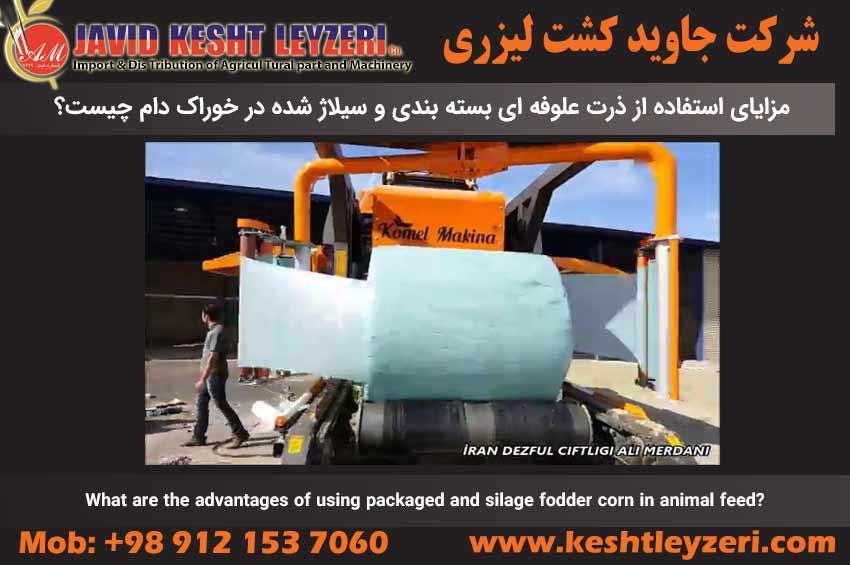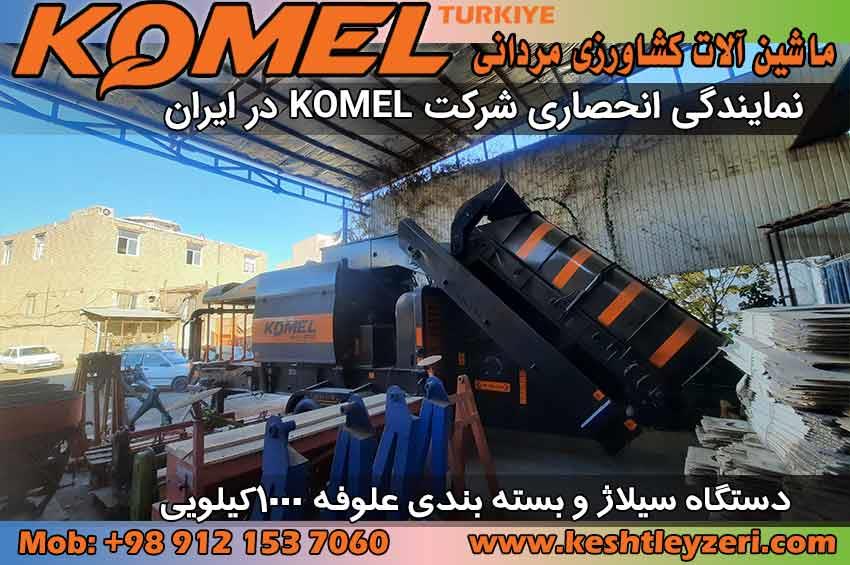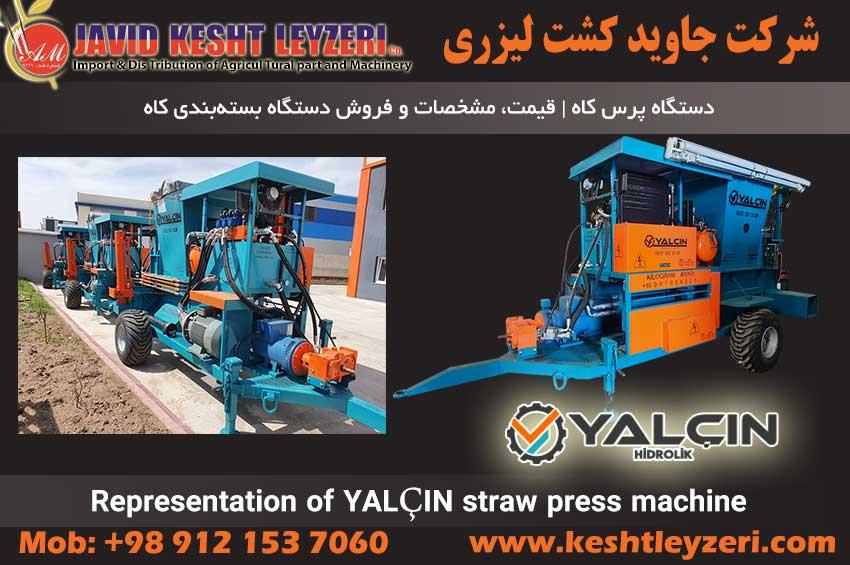
What are the advantages of using packaged and silage fodder corn in animal feed?
javid keshtleyzeri Co.ltd
In the following, the list of contents of this section is presented in the form of an article titled "Advantages of using fodder corn packed in animal feed":
What is a corn plant?
What is corn silage or corn packaging?
What are the goals of forage ensiling? What are the goals of forage silage?
What are the advantages of using fodder corn silage or fodder corn silage?
Why is the preparation and consumption of packaged fodder corn silage economical and safe?
What are the disadvantages of not using packaged fodder silage and storing fodder corn in ground silos?
What are the advantages and capabilities of the fodder corn packing machine?
What are the advantages of packaging silos compared to the traditional method?
In general, what are the advantages of using fodder corn in animal feed?
What is a corn plant?
Maize is a fodder and cereal plant that is cultivated in many regions of the world. This plant has long stems and broad leaves, and its fruits are known as "Kalvan" or "Bran". Corn is used as a rich source of energy and nutrients for humans and animals and plays an important role in the production of animal feed.
In fact, corn is a plant that grows well in warm and temperate regions, and its main origin is Central and South America. Although the history of its cultivation in other continents is not as long as America, it has many fans in these regions today. After wheat and rice, corn ranks third among cereal products.
What is corn silage or corn packaging?
Corn silage is a method of storing and using corn in which corn is mixed with other different fodder materials and then packed in a compressed and air-tight manner. This method preserves the nutritional and fodder value of corn and can be used as animal feed.
In fact, corn silage is one of the animal feed materials that is widely used due to its low cost. Due to its high carbohydrate content, this product has a better quality than other types of silage, and animals usually eat it more satisfactorily. Next, you will read the advantages and disadvantages of using corn silage and everything related to this topic.
What are the goals of forage ensiling? What are the goals of forage silage?
Corn silage is an effective way to preserve fodder and use it optimally in feeding livestock. The main objectives of fodder ensiling are:
1. Preservation of nutrients: By ensiling forage, nutrients such as protein, carbohydrates and vitamins are preserved in forage and their loss is prevented.
2. Extending life: Corn silage increases the life of forage by preserving nutrients and reducing spoilage, and provides livestock with access to quality forage throughout the year.
3. Reducing costs: Corn silage helps to reduce animal feeding costs due to its lower cost than other forage preservation methods.
4. Increasing the nutritional value of fodder by adding different substances to it, such as mineral salts and fermentation processes in it.
5. Reducing food contamination during storage.
6. Delicious increase in fodder.
7. Saving space and area for fodder storage.
8. The possibility of storing extra fodder in the growing season and using it in other seasons.
What are the advantages of using fodder corn silage or fodder corn silage?
Fodder corn has the highest dry matter compared to other plants.
It has low buffering properties.
It has a suitable level of water-soluble carbohydrates that provides satisfactory fermentation and sufficient lactic acid production.
It has a very high nutritional value and is almost similar to hay.
Why is the preparation and consumption of packaged fodder corn silage economical and safe?
1- Packaged fodder corn silage is one of the best and cheapest animal foods. This type of silage is hygienic and hygiene is observed in all stages of packaging. Also, by fully pressing the packaging, contamination of the surrounding environment is prevented and the silage inside the packaging does not spoil.
2- The packaging of fodder corn silage prevents the corn from getting mold and fungus inside the package and preserves its nutritional value. Also, with the full press of the pack, ideal silage conditions are provided and the silage ferments well.
3- The packed fodder corn silage has a high nutritional value and due to its constant weight, it can be easily transported and moved to any place without the need for re-weighing. This type of packaging saves the cost of building and setting up a silo.
4- The packed fodder corn silage has unique characteristics that make it considered as a safe option for livestock feeding. This type of silage produces more than 100 billion bacteria from each gram of sap produced and accounts for a large share of the fodder part of the cattle's diet.
5- Packaged fodder corn silage, considering that it can be stored in any corner of the livestock farm and has a high nutritional value, is considered as a suitable option for livestock feeding.
6- Packed fodder corn silage is easy to carry and move due to its constant weight and no need to re-weigh. This type of packaging saves the cost of building and setting up a silo. Also, due to the fact that it can be kept in any corner of livestock farming and has a high nutritional value, it is considered as a suitable option for feeding livestock.
7- The packed fodder corn silage has unique characteristics that make it considered as a safe option for livestock feeding. This type of silage produces more than 100 billion bacteria from each gram of sap produced and takes a large share of the fodder part of the cattle's diet.
8- The packaging of fodder corn silage prevents corn from getting mold and fungus inside the package and maintain its nutritional value. Also, with the full press of the pack, ideal silage conditions are provided and the silage ferments well. This makes the silage packed forage corn to be considered as an economical and safe option for livestock feeding.
9- The production of suitable acid with a high volume is necessary for a fast and desired fermentation with a suitable pattern, but the production of any other acid except lactic acid can cause slow fermentation, reduction of dry matter and undesirable and defective fermentation. The most suitable bacteria in favorable silage conditions is the one that can grow in high volume even in fodder that has inappropriate dry matter. Mainly produce lactic acid in high volume. In silage packaging, this is practical and possible since everything is under strict control.
10- The ultimate goal in using silage is to achieve healthy, cheap and tasty feed for producing milk and meat and maintaining the health of livestock. In the packaged silage, there is no bad and unpleasant smell for animal feed, and even the sharp smell of vinegar, which is related to acetic acid, is not noticeable. Correct fermentation and processing conditions in the production of packaging silage prevent the conversion of fodder sugar into weaker acids such as butyric acid and acetic acid, water and carbon dioxide. In this way, waste of energy and high waste is avoided.
11- Well pounding and quick removal of the air from the chopped fodder corn can be handled well by packaged silage; Because immediately after transporting the corn to the factory, it is placed under a vacuum chamber and after fermentation is controlled, which takes about four weeks, it is pressed under heavy presses, molded and packed, and is prepared to be transported and sent to the customer's address. .
12- The fermentation of silage is associated with biochemical changes. Disturbing bacteria and fungi break down the sugar in the fodder and turn it into inappropriate acids, water and carbon dioxide. The loss of silage dry matter, especially in the case of expensive fodder, can be very harmful for cattlemen and sheep herders. The highest percentage of silage dry matter loss occurs during the fermentation period. Packaged silage for livestock feed is the best way to shorten the fermentation period and achieve complete and correct fermentation in the shortest possible time and with the best possible quality.
What are the disadvantages of not using packaged fodder silage and storing fodder corn in ground silos?
The disadvantages of storing fodder corn in ground silos include the following:
1. The possibility of contamination: In ground silos, the risk of contamination by weeds and fungi is much higher, which may reduce the nutritional value of corn.
2. Storage: Storing fodder corn silage in ground silos requires careful care and monitoring of temperature and humidity conditions in order to prevent its corruption and damage.
3. Spoilage: In ground silos, the possibility of spoilage and spoilage of fodder corn silage is much higher, especially if proper storage conditions are not met.
4. Loss of nutrients: In ground silos, the possibility of loss of nutrients due to spoilage and spoilage is higher, which may reduce the nutritional value of silage.
5. The need for a large space: To store ground silos, a large and appropriate space is required, which may be limited at times.
6. In ground and common silos, fodder corn silage may lose 30 to 40% of its nutritional value and even be destroyed, depending on the conditions of storage and use.
7. Also, the use of heavy machinery to set up silos can lead to contamination into the forage corn silage for animal feed.
8. Adding layers of air will also facilitate mold and mildew growth of forage corn due to air exposure.
9. Among the other disadvantages of storing fodder corn silage in ground silos are the non-uniformity of the silage, the lack of hygiene in the setup and operation stages, the high costs of building and maintaining the silo, the failure to separate the healthy parts from the moldy and fungal parts, and the loss Nutrient loss of forage corn silage noted.
Due to these disadvantages, the packaging of forage corn silage is proposed as a more appropriate option for keeping and using in animal nutrition.
What are the advantages and capabilities of the fodder corn packing machine?
Since you are familiar with the benefits of using packaged corn, now it's time to know the capabilities of the devices associated with it.
1- This device has the ability to install HMI system along with modem for remote control and manual system to increase the operator's work speed in line with production.
2- The device has the ability to install a remote troubleshooting system by the device manufacturer.
3- This device has the ability to install a package production statistics system by sending SMS to designated numbers.
4- There is also the ability to remotely access the machine's PLC program to change the machine's automation times for packing different materials.
5- The device allows you to announce the number of packs and estimate the weight of the packed fodder at any time.
6- This machine is used to pack fodder corn for animal feed, sugar beet pulp, bagasse (sugarcane pulp), mash feed, alfalfa, vermicompost fertilizer, garbage and similar materials.
7- The device can be moved and installed quickly in different places without the need of the device manufacturer. It is enough to remove four screws and five electrical plugs so that the device can be easily removed and after the transfer, it can be reinstalled with the same method.
What are the advantages of packaging silos compared to the traditional method?
1. By using packing silos, the fodder corn is fully pressed with a pressure of 150 atmospheres, while traditional silos are not pressed well by using tractor and loader pressure.
2. Packaging silos They are very uniform.
3. In any corner of livestock farming and in different weather conditions, corn silage can be stored for animal feed.
4. Only one worker is enough to move the corn silage packing, while a tractor is needed to move the traditional silo.
5. Traditional silage quickly gets moldy when opened and up to 30% of the silage is damaged and unusable, but these problems are not seen in silage corn packaging.
6. The mold in traditional silos can lead to problems such as livestock poisoning, a sharp drop in production, and an increase in the possibility of abortion, which are not seen in packaged silo corn.
7. Using packaging silos leads to 30% savings in silo costs.
8. Scientific articles have shown that the amount of herd milk increases by 5 to 8% due to its high quality.
In general, what are the advantages of using fodder corn in animal feed?
The use of fodder corn in animal feed has many advantages. These benefits include the following:
1. Preservation of freshness: The packaging of fodder corn preserves its freshness and quality, because it prevents contact with air, moisture and environmental pollution.
2. Easy transportation: The packaging of fodder corn makes its transportation easier and without waste.
3. Increase shelf life: Proper packaging increases the shelf life of fodder corn and prevents its expiration time.
4. Improving the health of livestock: the use of fodder corn packed with appropriate quality can guarantee the improvement of the health and performance of livestock.
5. Increase in productivity: using quality fodder corn leads to increase in productivity in livestock breeding.
Due to these advantages, the use of fodder corn in animal feed can significantly improve the performance and health of animals.
Click on the following links to view pictures and videos related to the fodder packaging machine:






